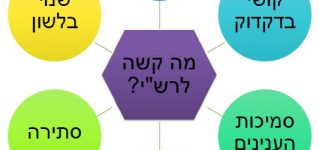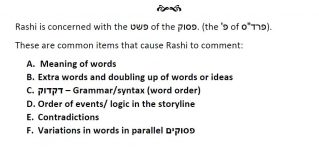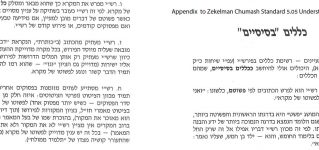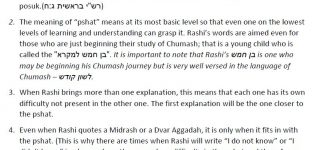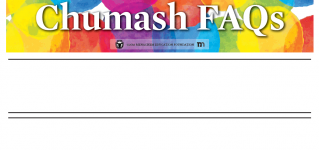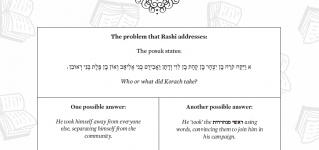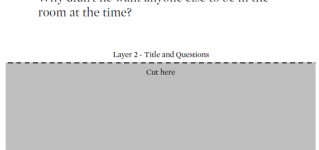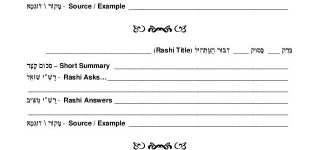רש”י Comprehension Skills
The students will be able to:
- demonstrate an understanding of רש”י’s methodology while analyzing the components of his commentary.
- use מפרשי רש”י to better understand רש”י’s commentary
| Enduring Understandings |
|---|
| 1. רש”י’s commentary follows particular rules which are prerequisites for understanding רש”י. |
| 2. “אני לא באתי לפרש אלא פשוטו של מקרא.” |
| 3. Literal meaning is not necessarily פשט; sometimes the “simple” meaning of the פסוק requires a figurative or deeper understanding. |
| 4. Learning רש”י isn’t an additional layer to our understanding but is a necessary component to complete our understanding. |
| 5. Close reading of the text is necessary in order to know what is bothering רש”י. |
| 6. רש”י’s commentary is precise and concise, and has multiple layers, so we need מפרשי רש”י to fully understand and appreciate it. |
| Essential Questions |
|---|
| 1. Why do I need רש”י?/ What is רש”י trying to do? |
| 2. How would I understand this פסוק without רש”י? |
| 3. What is פשט? / What is the “פשט” of this פסוק? |
| 4. What’s bothering רש”י? / How does רש”י make this פסוק clearer? |
| 5. How do the different elements and rules of רש”י help me find the information I need? / What clues should I be looking for? / What type of קושיא is רש”י addressing?[44] |
| 6. Why do I need this מפרש on a מפרש? / How does this מפרש help me better understand the פסוק? |
[44] See the kinds of anomalies and קושיאs listed in 4.b.07.
5.05 רש”י Script
B. N/A
C. N/A
D. N/A
B. N/A
C. N/A
D. N/A
B. Uses the דיבור המתחיל to identify רש”י’s question in learned רש”יs, after this was pointed out by the teacher.
C. N/A
D. N/A
B. Uses the דיבור המתחיל to identify רש”י’s question in learned רש”יs, when this was not pointed out by the teacher.
C. N/A
D. Identifies what רש”י uses as a support for his answer, (whether it is from the פסוק, other פסוקים, a מדרש, or another source) in learned רש”יs after it was pointed out by the teacher.
B. Uses the דיבור המתחיל to identify the question in unlearned (short and straightforward) רש”יs.
C. Uses רש”יs question to categorize the type of רש”י.
[47]D. Identifies what רש”י uses as a support for his answer, whether it is from the פסוק, other פסוקים, a מדרש, or another source, in learned or unlearned (short and straightforward) רש”יs, when it is evident.
B. Uses the דיבור המתחיל to identify the question in unlearned (short and straightforward) רש”יs.
C. Uses רש”יs question to categorize the type of רש”י.
[47]D. Identifies what רש”י uses as a support for his answer, whether it is from the פסוק, other פסוקים, a מדרש, or another source, in learned or unlearned (short and straightforward) רש”יs, when it is evident.
B. Uses the דיבור המתחיל and עיקר שפתי חכמים to identify the question in unlearned רש”יs.
C. Uses רש”יs question to categorize the type of רש”י.
[47]D. Identifies what רש”י uses as a support for his answer, whether it is from the פסוק, other פסוקים, a מדרש, or another source, in unlearned (including long רש”יs with multiple sources) רש”יs, when it is evident.
B. Uses the דיבור המתחיל and עיקר שפתי חכמים to identify the question in unlearned רש”יs.
C. Uses רש”יs question to categorize the type of רש”י.
[47]D. Identifies what רש”י uses as a support for his answer, whether it is from the פסוק, other פסוקים, a מדרש, or another source, in unlearned (including long רש”יs with multiple sources) רש”יs, when it is evident.
Grades 3-4: Explains the question and answer of רש”י in the פשט after it was explained by the teacher.
Grade 5: Explains the question and answer of רש”י in the פשט after it was translated by the teacher, and רש”י’s question is easily understood.
Grade 6: Explains the questions and answer in learned רש”יs (including long רש”יs, and when there is more than one answer) and in unlearned (short and straightforward) רש”יs.
Grades 7-8: Explains the questions and answer in unlearned רש”יs, including long רש”יs, and when there is more than one answer.
Grade 3: Uses the דיבור המתחיל to identify רש”י’s question in learned רש”יs, after this was pointed out by the teacher.
Grade 4: Uses the דיבור המתחיל to identify רש”י’s question in learned רש”יs, when this was not pointed out by the teacher.
Grades 5-6: Uses the דיבור המתחיל to identify the question in unlearned (short and straightforward) רש”יs.
Grades 7-8: Uses the דיבור המתחיל and עיקר שפתי חכמים to identify the question in unlearned רש”יs.
Grades 5-8: Uses רש”יs question to categorize the type of רש”י.
[47]Grade 4: Identifies what רש”י uses as a support for his answer, (whether it is from the פסוק, other פסוקים, a מדרש, or another source) in learned רש”יs after it was pointed out by the teacher.
Grades 5-6: Identifies what רש”י uses as a support for his answer, whether it is from the פסוק, other פסוקים, a מדרש, or another source, in learned or unlearned (short and straightforward) רש”יs, when it is evident.
Grades 7-8: Identifies what רש”י uses as a support for his answer, whether it is from the פסוק, other פסוקים, a מדרש, or another source, in unlearned (including long רש”יs with multiple sources) רש”יs, when it is evident.
Resources
What’s Bothering Rashi? Graphic Organizer
This graphic organizer depicts the different categories of מה קשה לרש"י.
What’s Bothering Rashi?
This supplement goes through the different reasons that Rashi might comment, explaining the categories of מה קשה לרש"י.
Klalei Rashi (Hebrew)
The Lubavitcher Rebbe's Klalei Rashi introduce a systematic approach to the study of Chumash with Rashi. (Original Hebrew excerpt.)
Rashi Principles (English)
The Lubavitcher Rebbe's Klalei Rashi introduce a systematic approach to the study of Chumash with Rashi. (English version)
5.06 Summarizing רש”י
B. N/A
B. N/A
B. Explains the פסוק according to רש”י, when רש”י deals with translation or other factual clarifications, for learned רש”יs.
B. Explains the פסוק according to רש”י, when רש”י deals with translation or other factual clarifications, for learned רש”יs.
B. Explains the פסוק according to רש”י, for learned or unlearned (short and straightforward) רש”יs.
B. Explains the פסוק according to רש”י, for learned or unlearned (short and straightforward) רש”יs.
B. Explains the פסוק according to רש”י, for learned or unlearned (including long and complex) רש”יs.
B. Explains the פסוק according to רש”י, for learned or unlearned (including long and complex) רש”יs.
Grades 1-2: N/A
Grades 3-4: Restates רש”י’s commentary in one’s own words, for learned רש”יs.
Grades 5-6: Summarizes רש”י, stating the main idea in one’s own words, in learned or unlearned (short and straightforward) רש”יs.
Grades 7-8: Summarizes רש”י’s commentary stating the main idea(s) in one’s own words , in learned or unlearned (including long and complex) רש”יs.
Grades 3-4: Explains the פסוק according to רש”י, when רש”י deals with translation or other factual clarifications, for learned רש”יs.
Grades 5-6: Explains the פסוק according to רש”י, for learned or unlearned (short and straightforward) רש”יs.
Grades 7-8: Explains the פסוק according to רש”י, for learned or unlearned (including long and complex) רש”יs.
Resources
What’s Bothering Rashi? Graphic Organizer
This graphic organizer depicts the different categories of מה קשה לרש"י.
What’s Bothering Rashi?
This supplement goes through the different reasons that Rashi might comment, explaining the categories of מה קשה לרש"י.
Klalei Rashi (Hebrew)
The Lubavitcher Rebbe's Klalei Rashi introduce a systematic approach to the study of Chumash with Rashi. (Original Hebrew excerpt.)
Rashi Principles (English)
The Lubavitcher Rebbe's Klalei Rashi introduce a systematic approach to the study of Chumash with Rashi. (English version)
5.07 Dividing רש”י
Grades 1-3: N/A
Grade 4: Divides a learned רש”י into its various components (e.g. דיבור המתחיל, question, answer, supporting evidence).
Grades 5-6: Divides a learned or unlearned, (short and straightforward) רש”י into its various components (e.g. דיבור המתחיל, question, answer, supporting evidence).
Grades 7-8: Divides a learned or unlearned (including long and complex) רש”י into its various components (e.g. דיבור המתחיל, question, answer, supporting evidence).
5.08 מפרשי רש”יi[45]
B. N/A
C. N/A
B. N/A
C. N/A
B. N/A
C. N/A
B. N/A
C. N/A
B. N/A
C. N/A
B. Navigates from רש”י or a particular portion of רש”י to the מפורש that comments on or relates to it.[47]
C. Explains the רש”י according to the מפרשי רש”י learned.
B. Navigates from רש”י or a particular portion of רש”י to the מפורש that comments on or relates to it.[47]
C. Explains the רש”י according to the מפרשי רש”י learned.
Grades 7-8: For each of the מפרשי רש”י learned, explains the role of the commentary in relation to רש”י,i[46] and its particular style or שיטה.
Grades 7-8: Navigates from רש”י or a particular portion of רש”י to the מפורש that comments on or relates to it. [47]
Grades 7-8: Explains the רש”י according to the מפרשי רש”י learned.
[45] We recommend שפתי חכמים for grades 7 and 8. If a teacher chooses to advance further, they can go to גור ארי–ה and רמב“ן.
[46] I.e. elucidate, argue, etc.
[47] E.g.: For שפתי חכמים, the small letters within רש“י. For תרגום, to find the quote in אונקלוס when רש“י says כתרגומו. For רמב“ן or גור אריה, to locate the same דיבור המתחיל.

